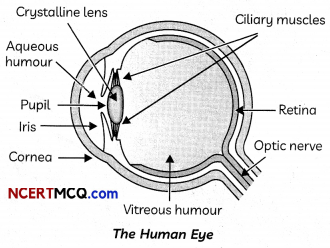The Human Eye
Optical instruments, including our eyes, extend the range of our vision and enable us to see objects varying in size from very tiny, nearby objects to very large, distant objects, in this chapter we shall study about the human eye and optical phenomena in nature, such as rainbow formation, splitting of white light and blue colour of the sky, etc.
The human eye is one of the most wonderful sense organs as it enables us to see various things and colours around us. It is like a camera.

Parts of the Human Eye
Retina:
This is a light sensitive screen inside the eye on which an inverted and real image of an object is formed by the eye lens. It contains light sensitive cells called rods and cones.
Cornea:
Cornea is a thin membrane covering the transparent bulge on the surface of the eyeball and through which light enters the eyes.
Aqueous Humour:
Aqueous humour acts as a lens along with the cornea and provides most of the refraction of light rays entering the eyes.
Crystalline Lens:
Crystalline lens provides the finer adjustment of focal length required to focus objects lying at various distances on the retina. It is composed of a fibrous jelly-like substance.
Iris:
Iris is a dark muscular assembly which lies behind the cornea and controls the size of the pupil.
Pupil:
Pupil is a variable aperture which regulates the amount of light entering the eyes. When the light is very bright, the pupil becomes very small (as the iris muscles contract) and in dim light, it opens up (as the iris muscles relax).
![]()
Ciliary Muscles
The ciliary muscles change the shape or curvature of the eye lens so that nearby, as well as distant objects, can be focused. The ciliary muscles contract when we are looking at nearby objects so that the eye lens becomes more round in shape thus reducing the focal length of the lens. When looking at distant objects, the eye lens relaxes, so that these objects can be seen clearly. The focal length of the eye lens is about 2.5 cm when the muscles are relaxed.
Visual Impairment
If due to damage or malfunction of any part of the visual system, there is a significant loss of visual functioning, it is called visual impairment. It can be due to damage to any of the structures involved in the transmission of light such as cornea, pupil, eye lens, etc or those responsible for the conversion of light to electrical impulses, like the retina or optic nerve.
Power of Accommodation
Power of Accommodation is the ability of the eye lens to focus at nearby as well as distant objects by adjusting its focal length. For viewing nearby objects, the eye Lens becomes thick and for viewing distant objects, the eye lens becomes thin.
Least distance of distinct vision or near point: It is the minimum distance at which objects can be seen most distinctly without strain and is 25 cm for a normal eye.
Far point: It is the farthest point upto which the eye can see objects clearly and is infinity for a normal eye.
Power of accommodation: It is the maximum varia¬tion of the power of the eye for focusing on near and distant objects and is about 4 dioptres for a young adult with normal vision.
Cataract: It occurs when the crystalline lens of our eyes becomes hazy or even opaque due to the de-velopment of a membrane over it. It usually occurs at old age and leads to the decrease or loss of vision, but can be corrected by surgery.
Reason for having two eyes: Plaving two eyes gives us a wider field of view of about 180° with two eyes as compared to 150 with one eye. It also enables us to detect faint objects. Our eyes are positioned on the front of our heads which reduces the field of view in favour of stereopsis.
![]()
Example 1.
Why is a normal eye not able to see clearly the objects placed closer than 25 cm?
Answer:
A normal eye is not able to see clearly the objects placed closer than 25 cm as there is a limit to which the ciliary muscles can change the curvature of the eye lens. If the object is held closer than 25 cm, there is a lot of strain on the eyes.